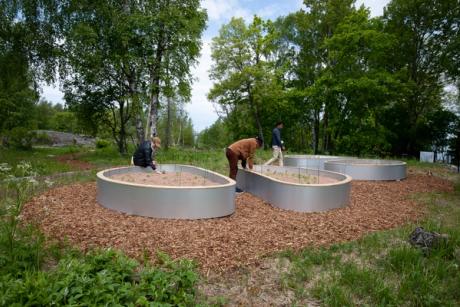
The second Helsinki Biennale, which was launched last week (until September 17), sheds light on the current issue of sustainability in the art world. Exhibition sites include the Helsinki Art Museum and Vallisaari Island, a 20-minute ferry ride from the capital.
The biennial, which brings together the works of 29 artists and artists’ collectives, takes its title, New directions may emergefrom a quote by American anthropologist Anna Lowenhaupt Tsing who said: “As contamination alters world-making plans, mutual worlds – and new directions – may emerge.”
The curatorial concept expands on the question of contamination, focusing on how “on the island of Vallisaari there are contradictions at play: the unique biodiversity of the island and its protected status of the ‘environment. [are] against remnants of military contamination (gunpowder magazines),” writes curator Joasia Krysa, Professor of Exhibition Research and Head of Art and Design at Liverpool John Moores University, in the introduction from the catalog.
Finnish artist Tuula Närhinen has created one of the biennial’s most prescient pieces, The plastic horizon (2019-23), including plastic debris such as toys, bottle caps and plasticized tubes used in mine and construction site blasting operations, collected over the years from the shores of Helsinki.
“I believe that my two works, the Long-term deposits at the Helsinki Art Museum and The plastic horizon on the island of Vallisaari contribute to a broader discussion about the intertwining between urban life and the bodies of water that surround us,” she says. The Arts Journal. For 20 years she has been monitoring the Baltic Sea from her studio on the island of Harakka.
“Compelling political and technological issues of infrastructure, land use and trade are at stake when a city, such as Helsinki, continues to grow and expands out to sea merging neighboring islands with the continent by using earth fill and blasting the bedrock,” she adds.
TBA21-Academy in Venice, an ecological offshoot of the contemporary art foundation TBA21 (Thyssen-Bornemisza Art Contemporary), is co-sponsor and jointly produces two works as part of the biennial: Hypoxia (2023) by Lithuanian artist Emilija Skarnulyte and Oikos (2023) by Sami artist Matti Aikio. The latter’s multi-channel video on Vallisaari examines how humans interact with animals, also addressing “conflicts around the use of natural resources, nature conservation [and] fossil-free energy,” according to a project brief.
“Despite the multiple angles and viewpoints, I believe there is an extraordinary level of cohesion across the [biennial] works,” says Markus Reymann, director of the TBA21-Academy.
The bigger issue here, however, is whether biennials can ever be sustainable in light of the sheer volume of works and people on the move. “Coming out of the pandemic, we were forced to reflect and reassess the way we live and our impact on this planet,” says Krysa. “Think of the art world; there are around 300 biennials a year. It’s not the most durable model. We have to start thinking about it. »
Reymann says: “Of course the parts can be controlled [and sustainable] such as the use of materials, energy and ensuring trips are planned around multiple engagements in a city or country, rather than just showing up for an opening or conference.
Co-commissioned works will travel after the biennale with the smallest possible carbon footprint, he adds. “The fact that parts of the biennale are installed in the air-conditioned halls of the Helsinki Art Museum and other parts are presented on an island accessible only by boat has a carbon footprint. On the other hand, the island and the structures on it are highly regulated environmentally.
“Overall, I fear that no human activity of this magnitude can ever be called sustainable. However, each individual, including the participating artists, can take responsibility for their own actions, even if the effort may seem insignificant,” says Närhinen, emphasizing how his piece Long-term deposits– a 34 day record of the Thames tides – can be packed in three cases.
“That’s how the work traveled from London to Helsinki stacked on a single pallet. It may seem like small potatoes, but personally I find comfort in trying to make things happen in the most feasible and economical way possible,” she says.
Other highlights include a series of sculptures by Argentinian artist Adrián Villar Rojas generated through an amalgamation of software systems known as the Time Engine (The end of imagination, 2023). The works, camouflaged among the shrubs of the island of Vallisaari, reflect the “deadly materiality” of existence, according to the catalog, accentuating the temporary nature of human civilization.
The work most suited to the island is a garden installation by artist duo PHOsfate (Mohamed Sleiman Labat and Pekka Niskanen) which focuses on environmental issues such as ocean eutrophication – when nutrients from waste agricultural, industrial and urban are entering the seas, leading to the disruption of marine ecosystems. The sandoponic water-preserving gardens set up on Vallisaari are used for growing potatoes, kale and salad.
